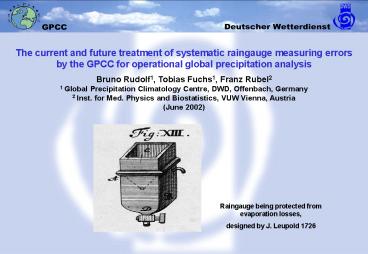Kein Folientitel - PowerPoint PPT Presentation
1 / 17
Title:
Kein Folientitel
Description:
by the GPCC for operational global ... Sorting data from the synoptic structure into time-series. ... factors from synoptic stations to other stations. ... – PowerPoint PPT presentation
Number of Views:35
Avg rating:3.0/5.0
Title: Kein Folientitel
1
The current and future treatment of systematic
raingauge measuring errors by the GPCC for
operational global precipitation analysis Bruno
Rudolf1, Tobias Fuchs1, Franz Rubel2 1 Global
Precipitation Climatology Centre, DWD, Offenbach,
Germany 2 Inst. for Med. Physics and
Biostatistics, VUW Vienna, Austria (June 2002)
Raingauge being protected from evaporation
losses, designed by J. Leupold 1726
2
- Correction of raingauge-measured data due to
systematic errors - Given conditions for the operational task of the
GPCC - Raingauge data from worldwide up to 50,000
stations are used. - Precipitation data have to be corrected for
many different gauge types. - Instrument characteristics are unknown for
many of the stations. - Auxiliary metorological parameters are not
measured at most of - the raingauge stations.
- An applicable correction method needs to be based
on information - being actually available !
3
- Correction of raingauge-measured data due to
systematic errors - The procedure still being used operationally at
the GPCC - The systematic error is quantified based on
Legates climatology - (corrected versus uncorrected long-term mean
precipitation). - The station-related data used by GPCC are not
being corrected. - The gridded precipitation data sets
distributed by the GPCC also - are not yet corrected.
- Mean monthly correction terms are supplied by
the GPCC on the grid - complementary to the gridded precipitation
data. - Users are recommended to apply the corrections
terms on the - gridded product for bias reduction.
4
The current procedure GPCC delivers separately
two gridded data sets 1. The Monitoring
Product monthly precipitation in mm based on
uncorrected data (Sample January 2002) 2.
Mean monthly percentual corrections (Lcorr-Lmeas)
/ Lmeas in with max-corr 200 (Sample
mean January)
5
(No Transcript)
6
Precipitation phase and windspeed are the most
important parameters for correction of raingauge
observations
Correction ratio in of the data measured by
the Hellmann gauge (without windshield) as a
function of wind speed for solid, liquid and
mixed recipiation
7
Probability of solid and liquid precipitation as
function of air temperature and humidtity derived
from SYNOP data (Fuchs, T., J. Rapp, F. Rubel
and B. Rudolf, 2001)
solid
liquid
8
(No Transcript)
9
- Data processing scheme
- for SYNOP reports
- Sorting data from the synoptic structure into
time-series. - Quality-control of RRRTR coded groups using
information from wwW1W2 . - Decomposition of over-lapping RRRTR groups.
- Calculation of
- daily precipitation totals from quality-checked
and corrected RRRTR groups.
10
- Correction using precipitation phase and wind
speed from SYNOP reports - Decoding of T, Td and v10m.
- Separation of liquid, mixed and solid phase
using wwW1W2 and T and Td - Correction using a wind speed reduced from v10m
to instrument height. - Calculation of corrected daily precipitation
totals.
11
Percentual partitions of liquid and solid
precipitation phases for Europe (31-72N, 11W
- 44E) and period 1 Jan to 31 Aug 2001 based on
GPCC's phase scheme.
Mean daily and daily-based monthly precipitation
corrections for Europe (31-72N, 11W - 44E)
and period 1 Jan to 31 Dec 2001 and Legates'
mean monthly climatologic corrections.
12
Comparison of monthly percentual corrections in
of observed data derived from daily
corrections for the years 1996 and 1997 and
long-term mean monthly corrections after Legates
(Ungersböck et al. 2001)
13
Comparison of monthly percentual corrections in
of observed data derived from daily
corrections for the years 1996 and 1997 and
long-term mean monthly corrections after Legates
(Ungersböck et al. 2001)
14
Comparison of monthly percentual corrections in
of observed data derived from daily
corrections for the years 1996 and 1997 and
long-term mean monthly corrections after Legates
(Ungersböck et al. 2001)
15
Comparison of monthly percentual corrections in
of observed data derived from daily
corrections for the years 1996 and 1997 and
long-term mean monthly corrections after Legates
(Ungersböck et al. 2001)
16
- Systematic gauge measuring error - Summary
- The new on-event correction method of GPCC is
applicable because it is - only based on information beeing actually
available. - The new method deliveres precipitation totals
much closer to reality than the - use of climatic mean correction factors, because
it is includes the observed - year-to-year variation of precipitation phases.
- Still to do
- Development of an interpolation scheme for the
new monthly correction - factors from synoptic stations to other
stations. - Assessment of the accuracy of the new
correction method by variation - of all input parameters used.
- Completion of instrument parameter tables for
all gauge types being used.
17
- Systematic gauge measuring error
- GPCCs recommendations
- Precipitation data may be corrected best by
the originator - - but the measured data should be delivered
with the corrected data. - Corrections should be clearly indicated, the
method and the parameters - should be documented documentation should be
supplied with the data. - Information about the instrument
characteristics should be compiled by - the originator and be added in the meta data
catalog for each station. - The precipitation measurement intercomparison
program should continue - including all new instruments. Results
should quickly be published.































